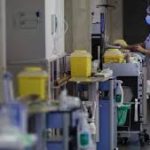Course Overview:
This course provides a comprehensive understanding of engineering systems in hospitals, focusing on design, analysis, and problem-solving. It addresses critical topics that impact hospital operations and patient safety, including electrical systems, power quality, radiation protection, electromagnetic interference, ventilation systems, infection control, and fire protection systems.
Course Objectives:
Participants will be empowered to:
- Evaluate and analyze various engineering systems used in hospitals.
- Develop effective strategies to ensure indoor air quality and patient safety.
- Understand and manage medical gas systems and modern applications such as telemedicine.
Training Content:
The course covers the following topics:
- Electrical Systems and Power Quality: Analyzing the design and operation of electrical systems to ensure the smooth functioning of medical devices.
- Radiation Protection Procedures: Evaluating the importance of these procedures in safeguarding patients and staff.
- Electromagnetic Interference: Analyzing its effects and ensuring compatibility among medical devices.
- Indoor Air Quality: Understanding its impact on health and strategies to improve ventilation.
- Infection Control: Assessing effective measures to prevent disease spread.
- Fire Protection Systems: Designing and evaluating their effectiveness in medical environments.
- Medical Gases: Understanding the design and operation of medical gas systems and developing maintenance strategies.
- Telemedicine: Evaluating applications for remote patient monitoring and medical consultations.
- Project Management: Developing skills to ensure efficient execution of engineering projects.
- Emergency Management: Analyzing response strategies for critical situations.
Course Outcomes:
By the end of the course, participants will be able to:
- Evaluate and design ventilation systems to ensure air quality.
- Understand and analyze infection control procedures.
- Manage medical gas systems for proper functioning.
- Analyze architectural design and equipment planning in medical facilities.
- Evaluate radiation and fire protection systems.
- Understand and apply telemedicine techniques in healthcare.
- Effectively manage engineering projects and handle emergencies efficiently.
Target Audience for the Course:
This course is designed for a diverse range of professionals interested in understanding and managing engineering systems in hospital environments, including:
- Biomedical Engineers: Involved in the design and maintenance of medical equipment and systems.
- Healthcare Facility Managers: Responsible for overall hospital management, focusing on engineering systems.
- Medical Technologists: Working with medical devices and systems, needing to understand engineering implications.
- Healthcare Safety Officers: Ensuring safety standards in healthcare settings, particularly regarding engineering systems.
- Electrical and Mechanical Engineers: Specializing in the design and analysis of relevant systems.
- Architects and Facility Planners: Designing hospital buildings and systems to meet healthcare needs.
- Public Health Officials: Focusing on healthcare system management and quality assurance.
- Emergency Management Professionals: Developing emergency response plans, understanding engineering systems.
- Graduate Students: Studying biomedical engineering or related fields seeking specialized knowledge.
- Healthcare Administrators: Involved in strategic planning and decision-making regarding engineering systems.
By targeting these audiences, the course aims to equip participants with essential knowledge and skills to effectively address and manage engineering challenges in hospital environments, ultimately improving patient safety and operational efficiency.






